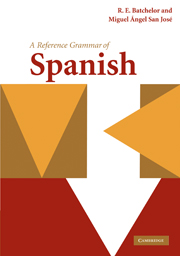Book contents
- Frontmatter
- Contents
- Preface/Prólogo
- Acknowledgments/Agradecimientos
- Abbreviations/Abreviaturas
- Introduction to the Spanish language/Introducción a la lengua española
- Part I
- Part II
- Part III
- Part IV
- Part V
- Part VI
- Part VII
- 62 Prepositions/Preposiciones
- 63 Compound prepositions/Preposiciones compuestas
- 64 Personal or distinctive “a”/Uso de la preposición “a” con el complemento directo
- 65 Prepositional constructions with verbs, nouns, adjectives and gerunds/Construcciones preposicionales con verbos, sustantivos, adjetivos y gerundios
- 66 The prepositions “para” and “por”/Las preposiciones “para” y “por”
- Part VIII
- Part IX
- Part X
- Appendix I Verb tables/ Tablas de verbos
- Appendix II Glossary/Glosario
- Bibliography/Bibliografía
- General index/Índice general
- Subjunctive index/Índice del subjuntivo
66 - The prepositions “para” and “por”/Las preposiciones “para” y “por”
from Part VII
Published online by Cambridge University Press: 05 June 2012
- Frontmatter
- Contents
- Preface/Prólogo
- Acknowledgments/Agradecimientos
- Abbreviations/Abreviaturas
- Introduction to the Spanish language/Introducción a la lengua española
- Part I
- Part II
- Part III
- Part IV
- Part V
- Part VI
- Part VII
- 62 Prepositions/Preposiciones
- 63 Compound prepositions/Preposiciones compuestas
- 64 Personal or distinctive “a”/Uso de la preposición “a” con el complemento directo
- 65 Prepositional constructions with verbs, nouns, adjectives and gerunds/Construcciones preposicionales con verbos, sustantivos, adjetivos y gerundios
- 66 The prepositions “para” and “por”/Las preposiciones “para” y “por”
- Part VIII
- Part IX
- Part X
- Appendix I Verb tables/ Tablas de verbos
- Appendix II Glossary/Glosario
- Bibliography/Bibliografía
- General index/Índice general
- Subjunctive index/Índice del subjuntivo
Summary
Below is a small passage illustrating the points at which para and por coincide and diverge in usage. The main feature here is that por, like para, may be used with the idea of intention, which is not always apparent for an English-speaker. The narrative is about a shortcut, a torn skirt and a rock concert.
Fui por el atajo (shortcut) para/por llegar antes y tomar el primer autobús que pasara, porque me interesaba llegar pronto por/para estar la primera, cuando abrieran la taquilla del concierto de rock.
Un momento antes, por/para salir pronto del trabajo, sin que se diera cuenta mi jefe, tuve que salir por la puerta trasera (rear door) por/para sortear el control de la puerta principal; para ello, hube de saltar una valla de alambre espinoso (barred-wire fence), desgarrándome la falda. Desde ese momento, por/para taparme el desgarrón que me había hecho, tuve que llevar el bolso junto a mi trasero todo el tiempo. Después, en el concierto, me até en la cintura un chal (shawl), que me dejó una amiga, para que/porque no se me viera el desaguisado (mess).
Distinguishing between “para” and “por”
The two Spanish prepositions para and por cause a great deal of confusion, partly because they can sometimes be translated by the same English preposition for, and also because they can overlap in meaning.
- Type
- Chapter
- Information
- A Reference Grammar of Spanish , pp. 392 - 398Publisher: Cambridge University PressPrint publication year: 2010



